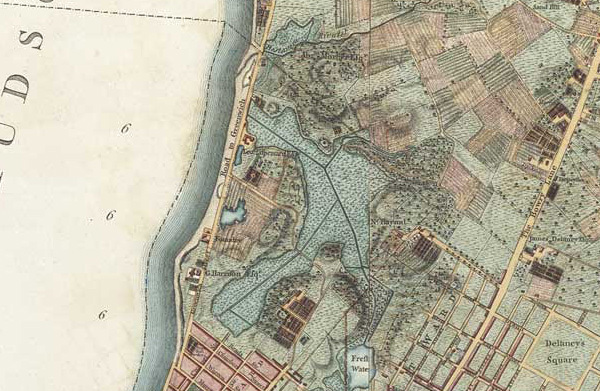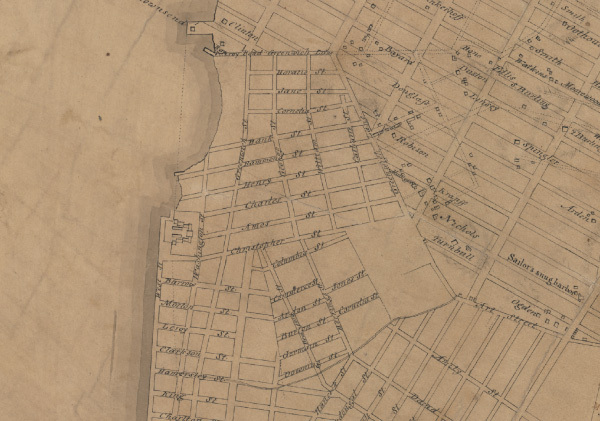Acquiring the ability to get to a destination in the West Village in under two hours isn’t the only reason I dropped six hundred dollars on the first iPhone, but it was in the top three.
In no other place on Earth have I seen so many confused tourists asking questions that can only be answered with nonsense: “How do I get to West 5th?” receives the cryptic: “There is no West 5th,” and “How do I get to West 11th?” gets this gem: “Just follow West 4th, it’s the third street after West 10th.”
Some areas of the map look like a Feynman diagram: streets burst into existence between other streets, only to curl back and vanish a few seconds later. The grid that makes the rest of Manhattan such an easily navigable place just fails outright, as if part of it broke off and was sewn back on by a child. The mind-spinning black hole of confusion centers around this godawful intersection:

West 4th street does a quantum tunneling trick, vanishing into 7th avenue and emerging from Stonewall Place, which is also Christopher Street depending on what sign you happen to see, then prances up to cross West 10th in a way that makes no fucking sense at all. If you sit on one of the many corners of this intersection, you can separate visitors from natives by the looks of fear they adopt as they exit the subway.
I decided to try to figure out how this nonsense happened, because it was that or practice violin, and my roommate was home and I didn’t want to cause him pain.
It would have been awesome to track this back to the Lenape in some fashion, and due to the nature of causality, there is certainly some link, but it was subtle or banal or foreign enough to escape the attention of white historians. It probably wasn’t a forward thinking “to hell with the white man” anyway, and my patience only goes so far. It would have been almost as awesome to track it back to the British, but the destruction that set a good chunk of the early city back to zero plus rubble happened too far south to set the blame on them.
The earliest map I could find was this one:

So we see in the center left what looks like a nice little farmstead, some trees and fields and roads, etc., very Anne of Green Gablesy. This apparently turned into a small community, a Greenwichy village, if you will. Later, between 1799 and 1822, there were a series of yellow fever and cholera outbreaks in the more developed, southern part of the city, and a bunch of people migrated up seeking temporary refuge in the area. We all know what “temporary housing” really means, so the village population exploded. By the mid 1800s, it’s a fairly established area.
So what? Here’s what: in 1807, they started working out the grid plan for Manhattan. Note that in this plan the island is already straightened out into the faux North-South layout that has little to do with reality, so it’s not the subway map’s fault. 1811 rolls around and they move forward with the grid. Great! Except that they weren’t sure what to do with this little part of the city from the outset.

I don’t know how thoroughly they consulted the existing denizens of the village when they drew up the plans, but as construction commenced, the locals lobbied hard to preserve the existing streets. This is the basic reason why they’re skewed from the rest of the grid, and they even managed to preserve their freaking cow paths, which created the awful little elbow streets, essentially allowing a few sections of the village to be designed via the Boston method, better known as Oh Just Pave It, I Don’t Have Time for This Shit.
So, as they built up the village and the surrounding grid, they faced some hard choices in how to wire up the surrounding streets. Again, I had someone in mind to blame, this time the Astors. I was dearly hoping for some evidence that Astor place was in some way responsible for the absence of West streets 5th through 9th, as the squares and parks between Astor Place and the West Village seem culpable, but I couldn’t find anything aside from this:

Careful investigation led me to conclude the evidence was faked, so I was forced to admit the streets didn’t go all the way over and that’s just the way it was. The engineers just had to make decisions about how to connect the remaining roads, and I think I can say with some authority that those decisions were terrible.
It’s hard to describe the hopelessness that fills the soul upon being lost in the Village for two hours and coming to the intersection of West 4th and West 10th for the first time. You merely gape at first, your capacity to reason momentarily crushed by the sense of betrayal. The realization comes slowly, but soon you know, beyond question, that there is no love in the universe, and we are merely dust passing to dust through a serious of callous jokes.
Why not rename the streets? Why not just angle them the same way? Was there so little foresight? We’ll never know, unless somebody writes me an angry letter explaining exactly why. It’s 100 degrees with 2000% humidity, so my research is over for the moment.
So the situation kind of sucks, but you get used to it. You learn to readjust your grid, and as long as you can navigate the periphery, you can survive.
That still doesn’t explain the intersection of madness.
This is what the spot looked like in 1912, after all the gridding settled down, with the red lines showing which streets had opened:

Not bad, right?
This is what it looked like in 1914:

Fucking 7th Avenue.
Why did 7th Avenue suddenly shoot its way directly through Greenwich Village in 1914? Because the commercial zone up in midtown wanted faster access to the warehouse districts in Tribeca and Greenwich, so they just drew a straight line between A and B and said, “Put a road here. In the future, we’ll throw up some chincy shops near this intersection, and visitors to our fair city will feel compelled to purchase things before asking for directions, at which time we will direct them to West 5th Street, amen.” And everybody hated them for it from the start.
So there we have it. Greenwich Village was brought to you by cholera, yellow fever, and the people who brought you the Triangle Shirtwaist factory fire.




